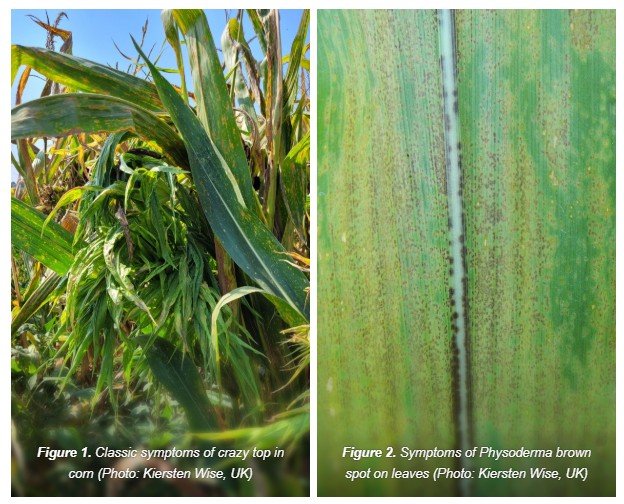Corn Diseases Associated with Ponding
Corn Diseases Associated with Ponding

Two minor diseases, crazy top and Physoderma brown spot, may be problematic in areas where corn is underwater for 24 to 48 hours.
Published in Kentucky Pest News
Recent rains and waterlogged soils have led to localized areas of ponding in emerged corn. Corn that is underwater briefly can recover but may be impacted by several diseases. Two minor diseases, crazy top and Physoderma brown spot, may be problematic in areas where corn is underwater for 24 to 48 hours.
Crazy Top
Crazy top is caused by a fungus-like organism called Sclerophthora macrospora. This pathogen survives in soil and infects young corn plants when there is excess rain or ponding in the spring. Crazy top symptoms are most often observed at tasseling when distorted and malformed tassels appear in areas that were ponded or saturated (Figure 1). However, in some fields, symptoms may be less diagnostic and include stunting, tillering, thin, yellow leaves, and barren plants. More on crazy top can be found in the UK publication Crazy Top of Corn.
Brown Spot
Physoderma brown spot is caused by the fungus Physoderma maydis, which also survives in soil and residue; it infects corn plants that are ponded or have excess water remaining in the whorl. The symptoms typically appear in the late vegetative stages through pollination and are characterized by very small chocolate brown or yellow lesions on the leaves and midrib (Figure 2). The lesions may appear in a banded pattern. The lesions can also be found on the stalk, leaf sheath, or ear husks. Read Physoderma Brown Spot of Corn for more information.
Management
Crazy top and Physoderma brown spot rarely need management and are usually only problematic when water covers the whorl of the plant for short periods of time. Improving soil drainage and removing infected plants will reduce the disease risk for subsequent crops. Fungicides are labeled for Physoderma brown spot management, but symptoms are usually not severe enough to warrant preventative fungicide applications.

